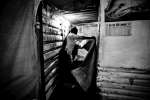- Text size
 |
|  |
|  |
| 
- Français
Zimbabwean teenage asylum-seeker learns the high cost of freedom
News Stories, 17 December 2009
MAKHADO, South Africa, December 17 (UNHCR) – When 18-year-old Tsitsi Makwiyena looks down at her son Desmond in her arms, she sees not just a one-week-old perfect baby boy, but also the high price she paid to escape her home country of Zimbabwe and start a new life in urban South Africa.
With a family too poor to let her finish high school, the girl, then just 17, decided to head to South Africa last year in search of a better life and a chance at further education. She and two older women managed to get a ride with some South Africans driving a truck from her impoverished homeland back to South Africa.
At the famous Beit Bridge crossing, the driver promised, they, like so many others, would be able to sneak across a weak link in the border fence to enter South Africa illegally.
But then things went horribly wrong. Arriving at night, the truckers pulled over on the Zimbabwe side of the bridge, raped the women one by one and left them by the side of the road. Bleeding and in unimaginable pain, Tsitsi and the other women staggered around looking for help – but no one would come to their aid.
Somehow they managed to walk across the border into South Africa and apply for asylum documents in the border town of Musina. Tsitsi then made her way to Makhado, about 100 kilometres further inland.
In Makhado she realized she was pregnant. Rejecting her first impulse to get an abortion, she received medical care and all-important counselling at a South Africa hospital – the only reason she's able to tell her story in a calm voice today.
"Before the counselling, whenever I thought about what had happened to me I would just cry," Tsitsi confides to a UNHCR officer, after all the men are out of earshot. "I could not say what happened without crying. Now I am better. Besides, I can't think about what happened because now I must think about the baby."
No longer a schoolgirl, she has had to grow up in a hurry. One thing she hasn't had the nerve to do, though, is tell her family back in Zimbabwe how her venture to South Africa has turned out.
"I have heard this has happened to many Zimbabwean girls," she says. "Then they don't tell their mothers about the baby. I think if I told my mother, she would not be happy but she would accept us."
Makhado, strung out along the highway that runs from the border to Johannesburg, almost looks like a small town in the United States, with its strip mall and fast-food restaurants.
But that's not Tsitsi's Makhado – hers is around the corner and down a small track to a tiny, dingy room built in the backyard of another house. She rents the room from an older woman from Zimbabwe, along with other tenants, mostly asylum-seekers transiting through Makhado on their way to Johannesburg.
Some 10 or 12 other people live there, mainly single men, and they all cook and do their laundry outdoors. Despite the grim surroundings, with the new responsibility for her young son, Tsitsi is determined to make a go of it in South Africa. "I will stay here in Makhado," she says resolutely, "and look for work."
Thousands of other foreigners, including refugees and asylum-seekers, are also struggling to get by in urban sprawls like Makhado. South African's generous law allows asylum-seekers and refugees to enjoy many benefits, including education and employment, but it is a hard life for most.
By Tina Ghelli in Makhado, South Africa


























